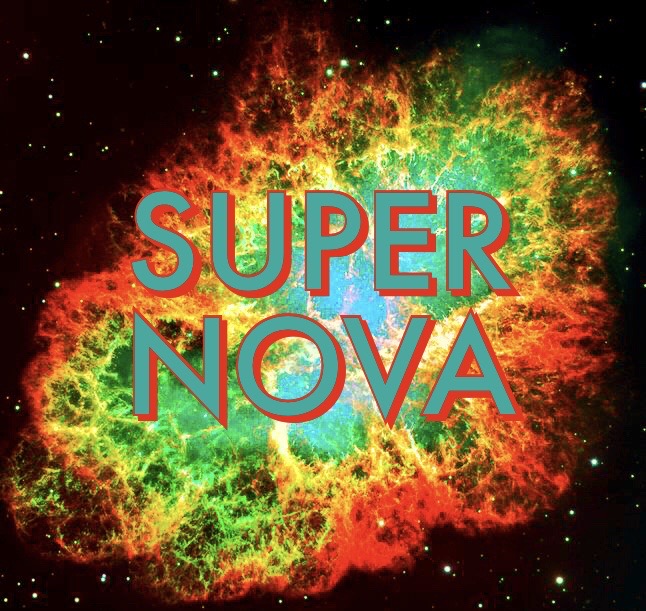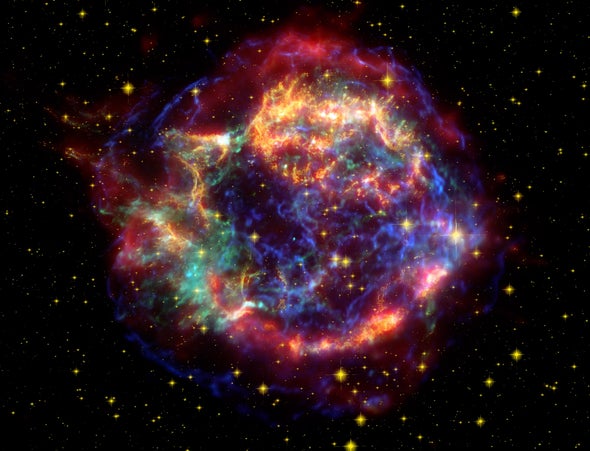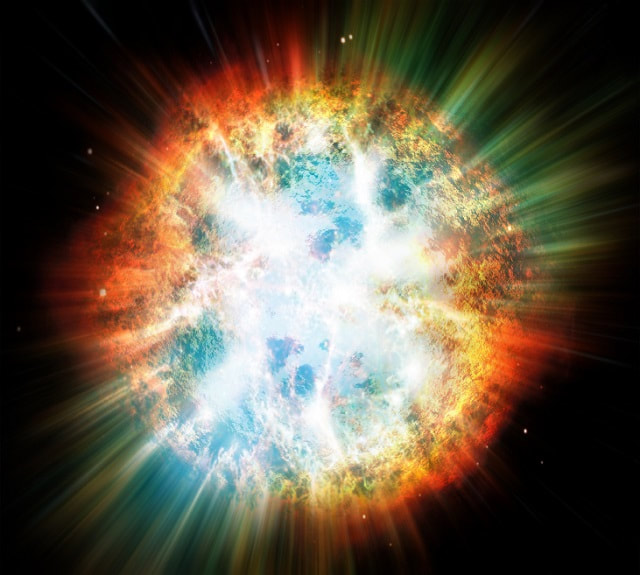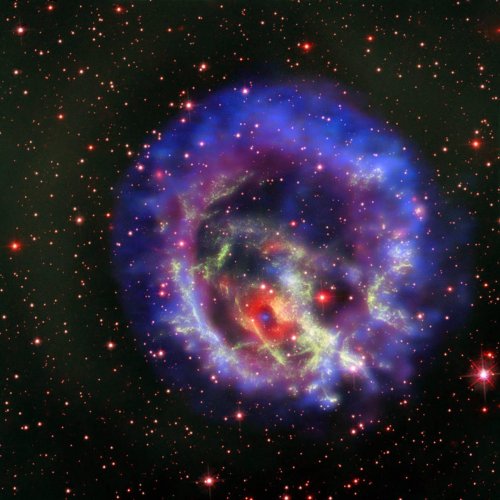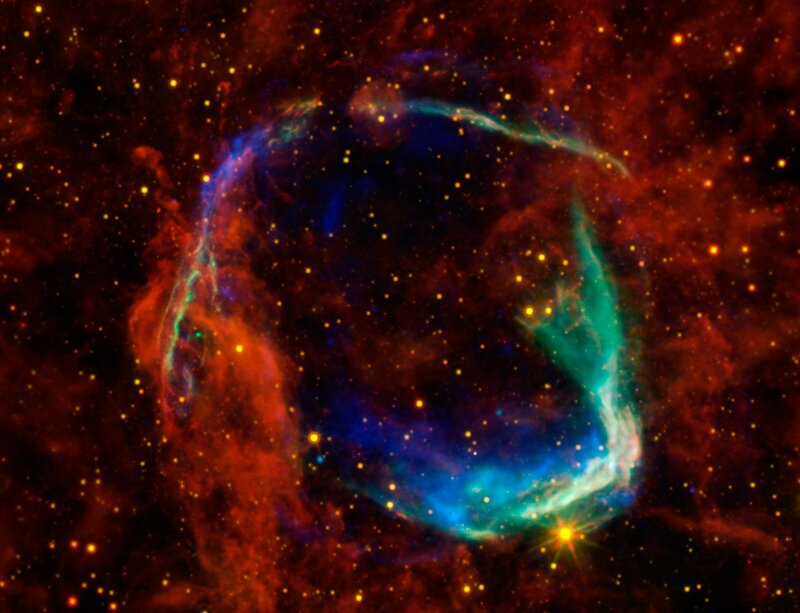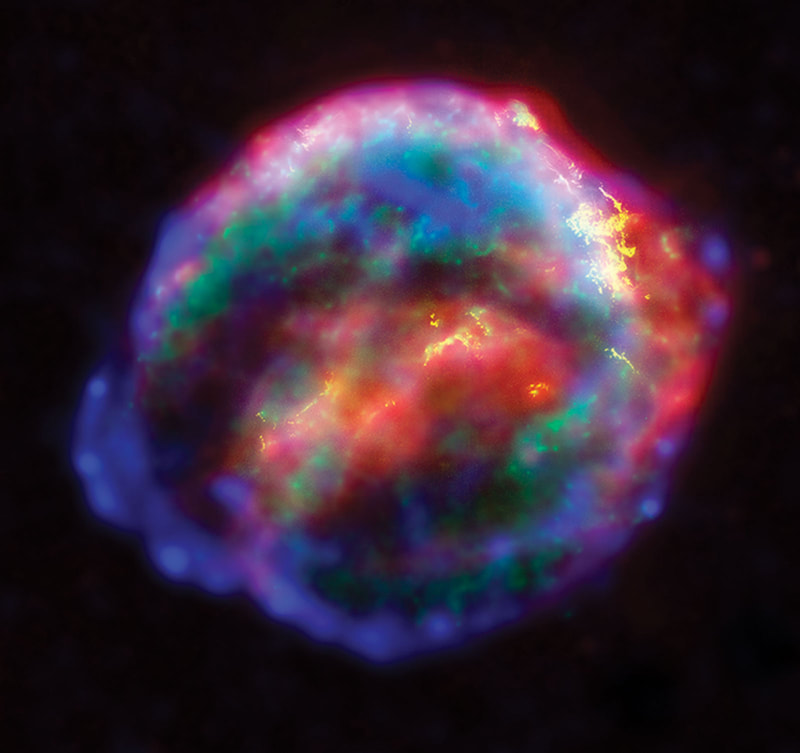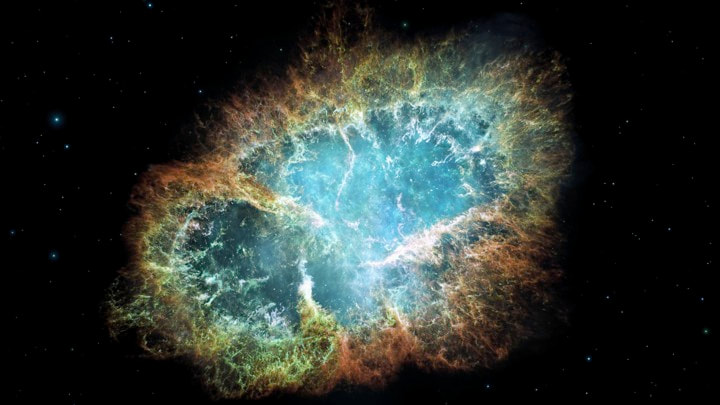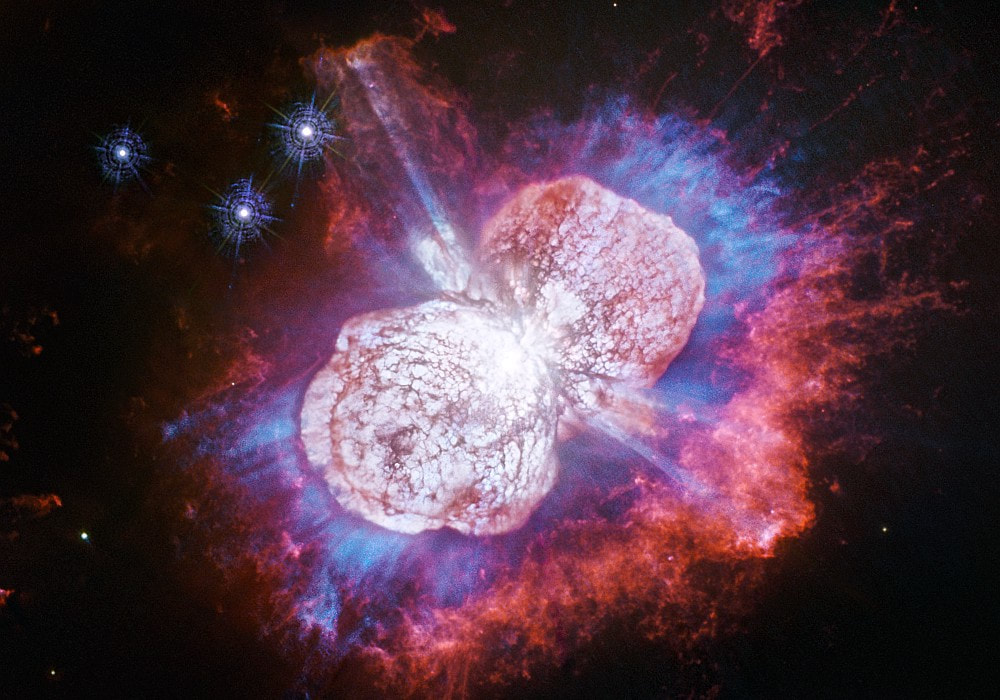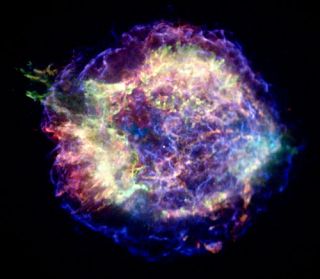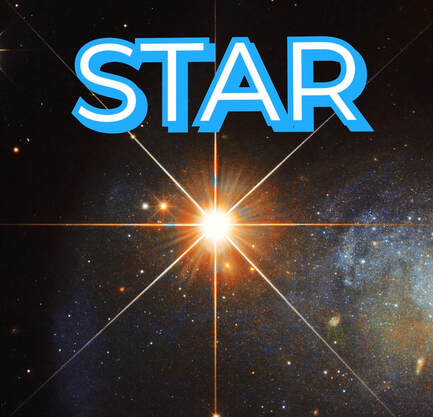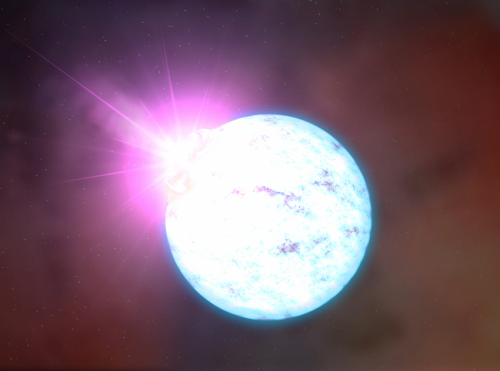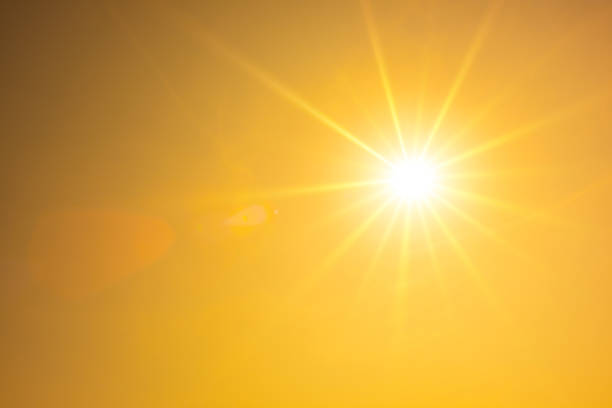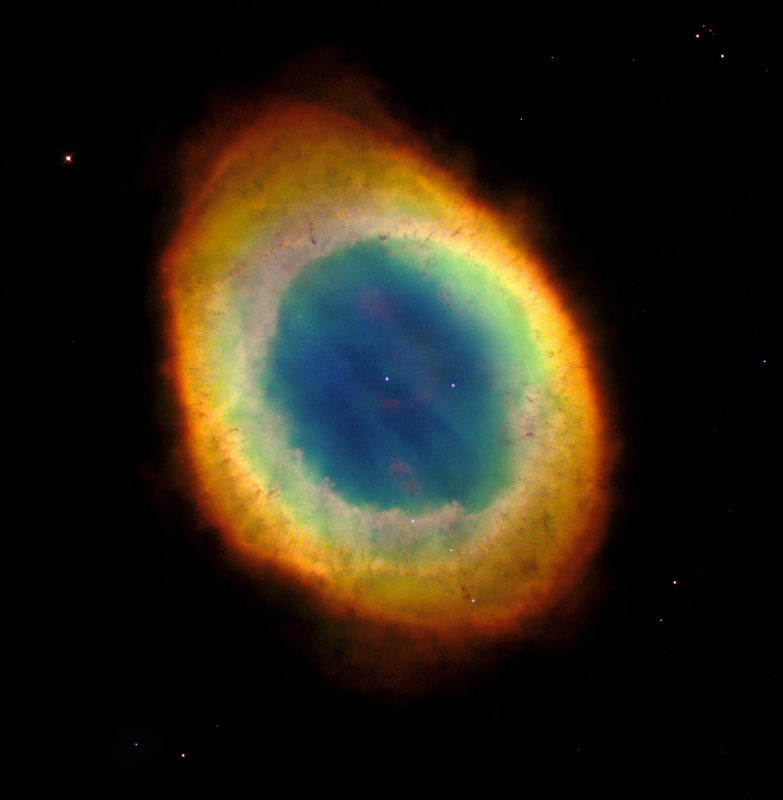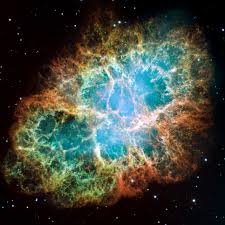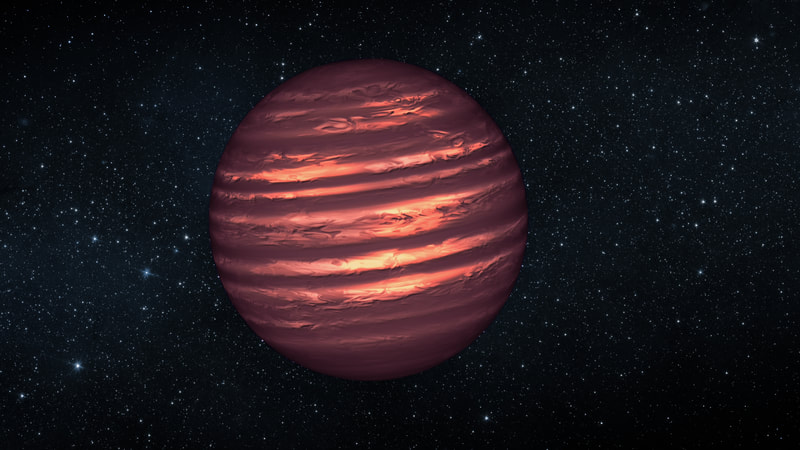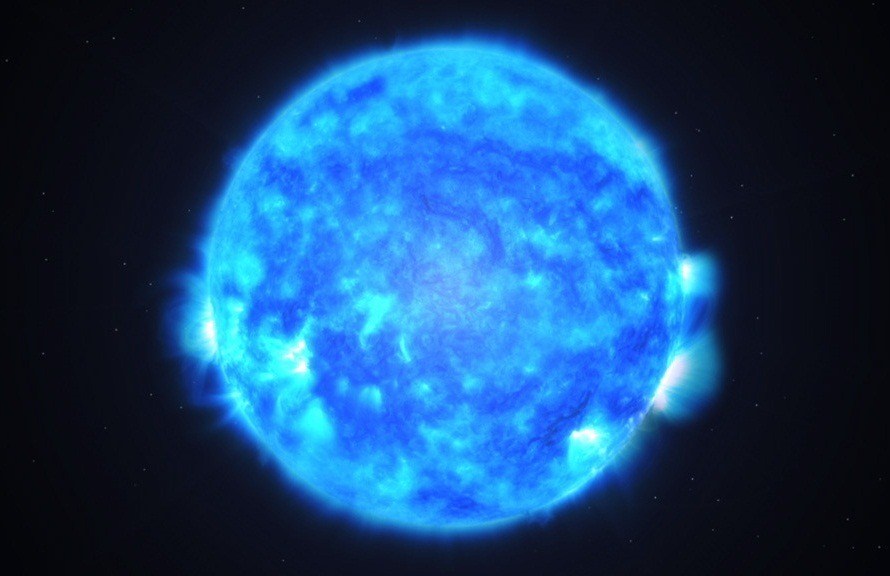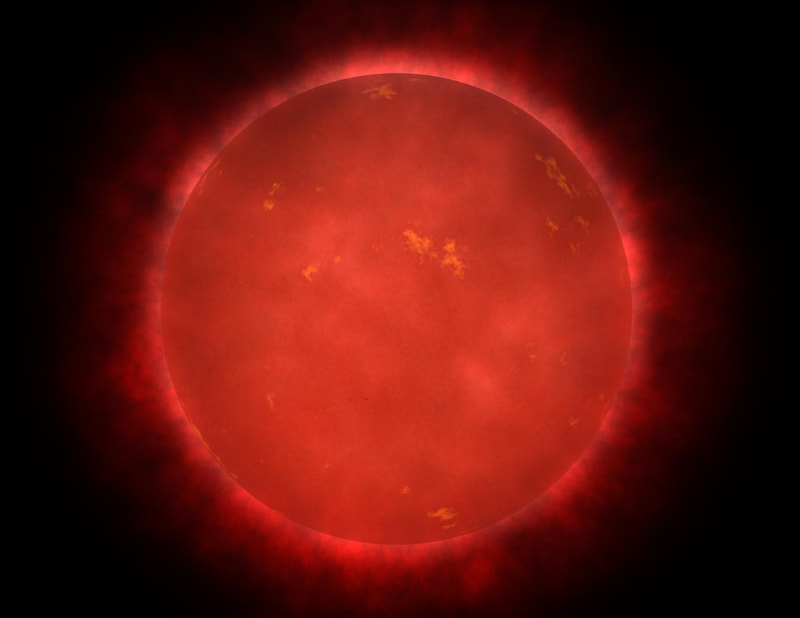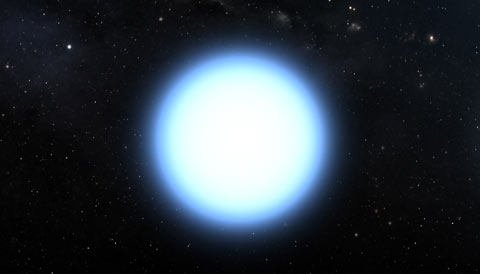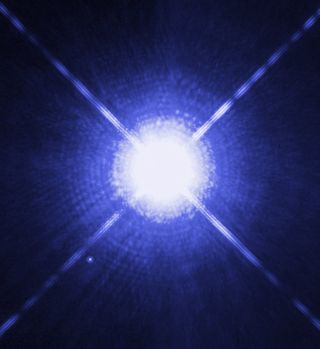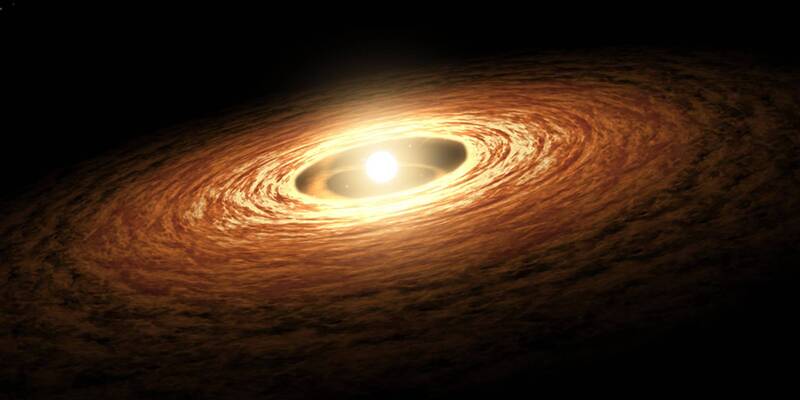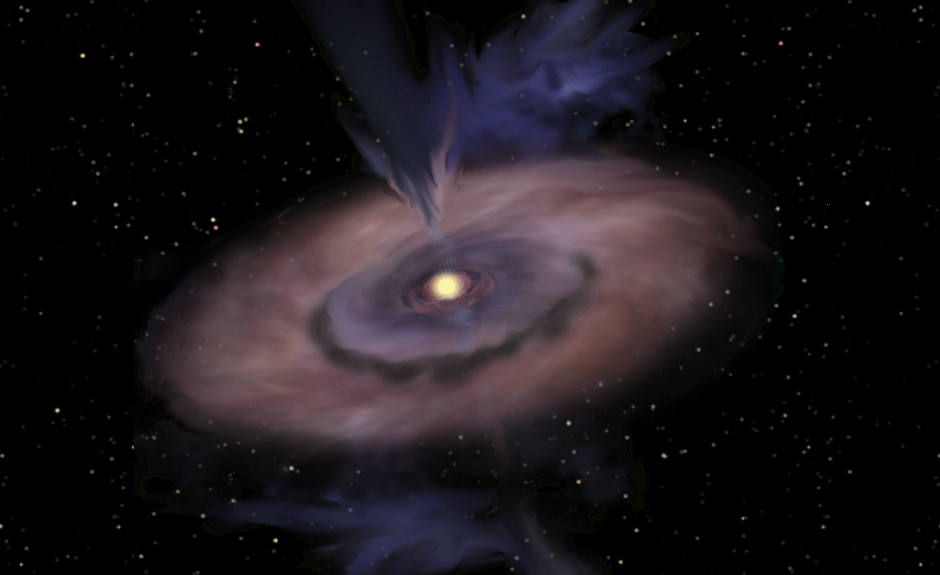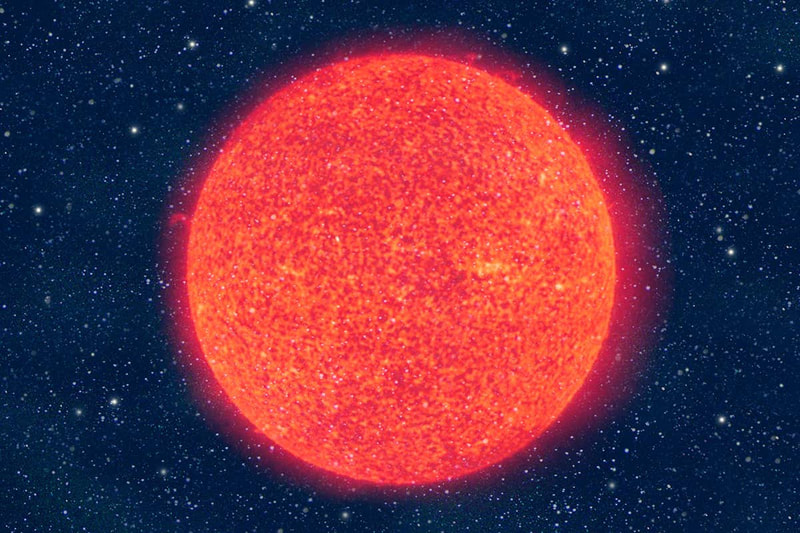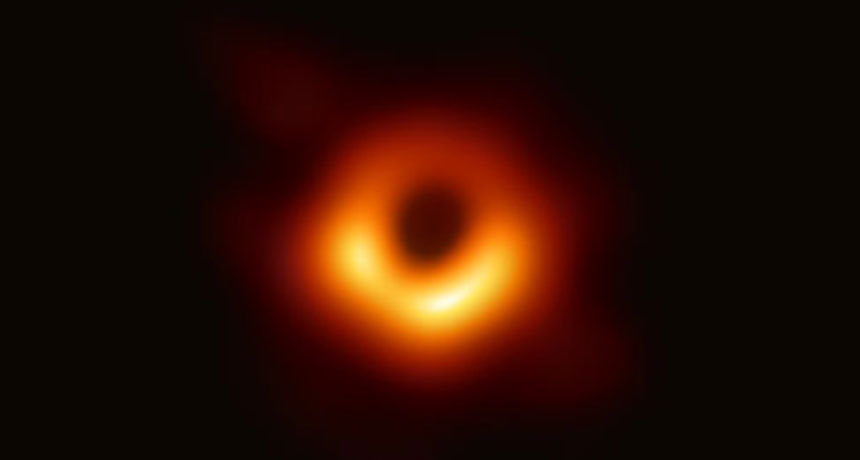|
Introduction
A SuperNova is a Super Powerful Stellar Explosion of Awesome magnitude! The Explosion is so Super Awesome, that it is in fact the largest Explosion in Space! Many elements that we see in The Universe are created by SuperNovae; but what creates a Supernova? A Giant death. The Demise of a The Giant A Supernova can never come from a Star like our Sun, no it must come from a Giant Star or even a Super Giant Star! A Supernova can come from either a Red Giant, Red Supergiant, Blue Giant or Blue Supergiant. All these Stars are very different, therefore there are more than one type of Supernova. There is a Type 1 Supernova, which comes from a Blue Supergiant and then there is a Type 2 Supernova, which comes from the other giants. Type 1 Supernova A Type 1 Supernova is split into three categories, Type 1A Supernova, Type 1B Supernova & Type 1C Supernova. A Type 1A Supernova is a Supernova that has a Strong ionized silicon absorption line. An absorption line is a proclivity of a lower temperature atmospheric gas to intake the equivalent lines of light. Type 1A Supernovae are close to being peak light! Type 1A Supernovae is considered Thermal runaway. Thermal runaway is when a white dwarf star gathers up enough astronomical material from Stellar Companion/ Binary Star to boost its core temperature which will create carbon fusion. This carbon fusion will Start-off runaway nuclear fusion. This believed to be The Creator of a Type 1A Supernova. Type 1B Supernovae are Supernovae that show non-ionized Helium. These Helium lines are neutral. Type 1B is considered Core Collapse. Core Collapse is when Massive Stars, such as Blue Supergiants, Red Supergiants, Blue Giants and Red Giants, core collapses due to the gravity of the nuclear fusion within it. As thou might know, this phenomenon can result in two outcomes usually, Black Holes or a Super Massive Explosion! The only Supernova where Core Collapse does not ensue prior to its inception is a Type 1A Supernova, which explain earlier is from Thermal runaway. Type 1C Supernovae have a weak to no helium and a weak to no silicon absorption feature; Type 1B Supernovae have this second feature as well. Type 1C Supernova also come from Core Collapse of a Massive Star. Type 1C Supernovae can be created by Blue Supergiants. Type 2 Supernova Type 1 Supernovae do not show Hydrogen while Type 2 Supernovae show Hydrogen. Type 2 Supernovae are split as well as Type 1 Supernovae into seperate categories that describe the different characteristics of the particular Supernova. The different types of Type 2 Supernovae are Type 2P Supernovae, Type 2L Supernovae, Type 2n Supernovae & Type 2B Supernovae. Type 2P Supernovae are Supernovae that hath a flat stretch known as a plateau that decline in lumosity. This brightness in the Supernovae declines slower that Type 2L Supernovae. Type 2P Supernovae comes from Core Collapse of a Massive Star. Type 2L Supernovae has a steady and slow linear decline in lumosity, not a slow as Type 2P Supernovae, but still slow nonetheless. This decline in light occurs at its peak lumosity. Type 2L Supernovae are created by Core Collapse of a Massive Star just like the previous Supernovae discussed. Both Type 2P Supernovae and Type 2L Supernovae lack narrow lines completely. This is unlike Type 2n Supernovae who in fact have some narrow lines. The 'n' in fact has a purpose in stating that this particular Supernovae (Type 2n Supernova) has a few narrow lines. These lines that are spoke of are lines of hydrogen emissions; hence it being a part of the broader spectrum of Type 2 Supernovae. One way to describe a Type 2n Supernova is an Extremely Energetic Supernova. Type 2n Supernovae also come from a Core Collapse of a Massive Star. Type 2b Supernovae have weak hydrogen lines in its starting spectrum. Eventually though Type 2B Supernovae hydrogen lines become undetectable. Type 2 Supernovae can come from Blue Supergiants, Red Giants, Blue Giants & Red Supergiants. Afterlife of The Supernova Supernovae can end in many spectacular ways. Type 1 Supernovae can become a Stellar Nursery. A Stellar Nursery is a plot in Space where dense nebula/nebulae condenses and contracts gas and dust becoming The Creator of Stars in that area. Type 2 Supernova that were previously Blue Supergiants will become Black Holes eventually. Type 2 Supernovae that come from Blue Giants or Red Giants will become Neutron Stars. Conclusion Just like Stars, Supernovae come in a broad array of different breeds. Like most of space, the vast spread of different type of astronomical objects come in countless varieties. Supernovae might be considered the most beautiful and Awesome of all of these Space objects. This shows that destroying some old and past its time can create something new and more spectacular than before with elements of the old that make a marvelous spectacle to witness. We too can do the same. If something old is no longer working for thee, change what thou art commencing in life. Keep elements of the old so thou does not lose thy identity completely, but adapt to current situation and become a better more brighter version of thyself, just like a Star becoming, a Supernova!
0 Comments
the sunIntroduction The Sun, The center of The Solar System. The Power of The Solar System, The Super Power to be honest. Without The Sun, there would not be The Solar System, no Mercury, no Neptune & no Earth which means, no us. The Solar Power from The Sun gives us life. No Sun, No life. Where did our Sun come from however? What are its origins? Let's see the life of The Sun. The Origin of The Sun The Sun is 4.603 Billion Years old. In the beginning The Sun and all the planets in The Solar System were a molecular cloud of gas and dust. Around 4.57 Billion year ago, this molecular cloud collapsed under the weight of its own gravity. The Sun was now a protostar. The Sun would remain a protostar for 100,000 Years. The Next Stage for The Sun The Sun after being a protostar for long while was ready for the next step. The Sun became a Tauri Star. The Sun was a berserk hot powerful star that roared solar winds across the primeval solar system. This stage is where many of the things that are in The Solar System today were created. The Sun's Tauri Star phase lasted for a scant millions of years. The Main Sequence of The Sun Now The Sun is all grown up. It is a full star an adult star to put it simply. The Sun is now a Main Sequence Star. This happened after The Tauri Star phase of The Sun ended. It stabilized and is now a regular Hydrogen and Helium producer colossal ball of sweltering plasma. The Sun Today make up 99.86 Percent of the mass in The Solar System, that's insane considering how big Jupiter and Saturn are alone. That makes the Earth seem small and insignificant in the grand scheme of things. In fact over one million Earths can fit inside of The Sun! The precise measurements of its mass is 1.989 X 10^30 kilograms. That's a ton of zeros! The Sun also has a radius of 432,170 Miles and it's 92.96 Million Miles away from Earth! Just to put that in perspective a Marathon race is 26.2 Miles, and the distance from New York City to Rome, Italy is a measly 4279 Miles. That's a long race to The Sun. Plus once you'd get there you would die. The surface temperature of The Sun is 5,778 degrees Kelvin which is 9941 degrees Fahrenheit and 5505 degrees Celsius. The Sun is one big scorching bright far-way over-powering element creating ball of flaming plasma. The Future of The Sun Our Sun is big and powerful now, but guess what. It's only going to get bigger. The Sun will eventually grow to be even greater in size than it is now. Our Sun will no longer be a Sun-Like Star, ironic to say the least, it will have become a Red Giant. It will be so large that the current position of The Earth will be inside of it. At this state in our Sun's life, it's days are number, it will have about 120 Million years left. Our Sun will be a gigantic big red ball of death. RIP The Sun The death will begin when the inner cores Helium begins to deteriorate and start to flash from The Sun in big powerful bursts. The Sun will begin to wane for 200 Million years and will eventually cool into a White Dwarf. The White Dwarf Sun will remain for Trillions of Years before turning off the light and becoming Black. The death of The Sun. Conclusion The thought of the thing that gives us Aloha "The Breath of Life" dying paints a meek and melancholy picture. This should not make us mournful however, for first of all, this is trillions of years away, the universe is only 13.8 Billion Years old, so this is farther away than the age of The Universe, a very long time. Also The Universe has a circle of life just like us humans. When one thing dies, something else is born. A new sun will be born somewhere in the universe and the life of the stars will continue on. Do not let the death of The Sun get thee down, for death is just a part of life and The Universe will roll on. Our Sun may die, but there are more just like it than grains of sand on Earth. That's something to be amazed and hopeful about. The Universe will continue to live on eon after eon, and so will the stars in sky. THe life of a starIntroduction
Stars are Awesome, Spectacular, Marvelous spheres of plasma in space. Living things on Earth see them every night and morning in fact; for our own sun is itself; a star. A star starts out as a cloud of bleak molecular gas. This states of things may remain for ages before one day, it collapses due to its own gravity. This may be triggered by a explosion nearby such as a Supernova or a comet. This is the beginning of a protostar. Protostar The protostar can be seen as a infant or baby star; not quite grown, but recognizable as a star. At this stage in a star's life cycle we see the beginning of rock formations known as planets. One can say that this is the start of a solar or planetary system. This era in a stars life last approximately one million years; short in astronomical terms. The universe being thirteen thousand & eight hundred times older than a million year old protostar. Tauri Star The next stage for the young star is the tauri star. A tauri star is born when a protostar stop receiving materials from it's gravitational pull. Now it is releasing a lot of energy; a kin to the baby realizes that breast milk is no longer on the menu; though I'm for certain that the two processes are quite different. Now the star is bright, and this is due to the energy from the gravitational pull of the materials falling into the adolescent star. This part of the star's life last about one hundred million years. Main Sequence Star Up next is the adult star, all grown up and ready to face the world, or worlds perhaps; introducing the Main Sequence Star . The Main Sequence Star comes in many sizes and colors and even temperatures. We have Red Giants, Brown dwarfs, Red dwarfs, Sun-Like Stars & Super Giants that are blue. This phase in a star's life is when it's a element-making juggernaut, pumping out many elements that power worlds like Earth. This is the longest phase in a stars entire life and it lasts around ten to fifteen billion years. That's older than the universe itself!!! A Main Sequence Star lasts a very long time so it's take awhile before what happens next. When the star meets its maker. Oh yes, even stars meet the grim reaper. The Death of a Star Now, many can happen during and after the death of a star. Some results quite beautiful actually. Sometimes Stars explode into Supernovas. Other times they become Supernovas and then collapse into Black Holes. There are times when it skips the whole Supernova steps and go straight to being Black Holes. A star can become a Supernova and then become a Neutron Star. A Neutron Star according to the Oxford Dictionary is "A celestial object of very small radius (typically 18 miles/30 km) and very high density, composed predominantly of closely packed neutrons. Neutron stars are thought to form by the gravitational collapse of the remnant of a massive star after a supernova explosion, provided that the star is insufficiently massive to produce a black hole." Sun-like Stars become Planetary Nebula then White Dwarfs after their time has passed. A Red Dwarf will become a white dwarf. Finally brown dwarfs is the only one who doesn't change; It was born a brown dwarfs, it dies a brown dwarf. There is an array of different outcomes for an array of stars. However, as all things in The World, the star does eventually kick the bucket. Conclusion This fact should not bring sadness however, for the circle of life does exist for stars too. Remember in the beginning, the birth of a star can be caused by a Supernova, a Supernova comes from a dead star, therefore one stars death could trigger the birth of many more stars. The life of stars goes on. This is true in life too. People and animals all get old and eventually pass away, but we leave behind offspring to continue our lives for us and in our predecessors we live on forever. |
About'Astronomy' page explores aspects of Astronomy, Philosophy, Spacelore and other topics about The Universe! Categories
All
Search
|
